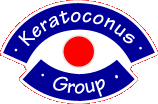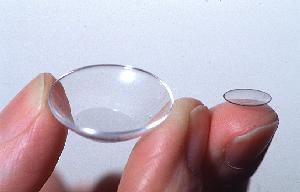Keratoconus in a paragraph
Keratoconus is something of a misnomer, along with many other medical conditions. The name suggests a conical shape, but there are many variants, few of which anything like resemble a cone. For some reason, the cornea becomes thinner than normal and distends, a process referred to as ectasia. As a result, the front surface of the cornea is more curved than normal, and often becomes irregular at the visual axis. So a more appropriate name for keratoconus is primary corneal ectasia, which describes the whole range of ‘keratoconus’ profiles. Some ophthalmology publications use this expression. In fact, it is more complex than thinning and distension, as many with keratoconus have experienced.
Why not spectacles?
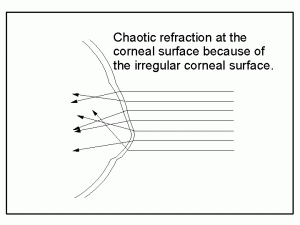
Spectacles may give a reasonable acuity in some low grade cases of keratoconus, but if moderate or advanced, spectacles may not help much because of the irregular keratoconic corneal surface. Even if a spectacle lens could be made to match the irregular corneal surface, nothing can be done to affect the chaotic refraction at the corneal surface.
Contact lens management of keratoconus
However, most people with keratoconus can see reasonably well with contact lenses of some kind.
Rigid corneal lenses
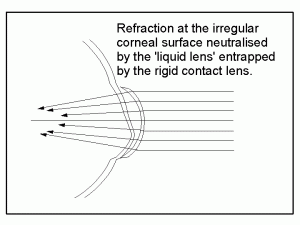
The latest information suggests that just somewhere around 6 or 7% of new contact lens fittings are corneal lenses these days. Cornealdefines the approximate size, ie fitting just on the cornea. Sadly, the corneal lens industry is in decline, but I believe there will always be contact lens companies who will continue to cater for keratoconus.
Rigid corneal contact lenses are and will remain the mainstream option for keratoconus. They offer functional vision for the majority of people with keratoconus because a fluid reservoir is trapped between the lens and the corneal surface. The refractive index is similar to that of the cornea so only a minimal amount of bending of rays of light (refraction) takes place at the corneal surface. The front and back surfaces of the contact lens are regular and usually spherical, so in effect, an artifical cornea is created.
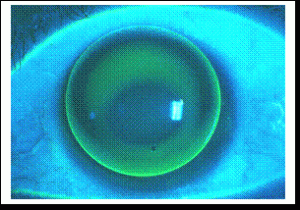
|
Rigid gas permeable corneal lens on the eye, photo with blue light to excite the fluorescein stained tears showing areas of corneal contact and clearance |
Rigid lenses are also sometimes called hard lenses, but this term is not in vogue now. With the widespread introduction of soft hydrogel lenses, there is the unavoidable odious comparison of a nasty ‘hard’ lens with a ‘nice, comfy’ soft lens. Rigid is not much better, but it defines the type of lens. Gas permeable materials have improved corneal physiology and wearing tolerance over the original material, ie non oxygen transmissible PMMA (Perspex), so most practitioners use the term hard to describe the odd one fitted with PMMA for some reason.
Hydrogels
Most people who wear lenses for conditions other than keratoconus, simple myopia, hyperopia and even regular astigmatism wear soft (hydrogel).
Hydrogel lenses which are used for regular myopia, such as daily disposables, are very thin; a piece of clingfilm is a term often used to describe them. They drape over the surface, so the front surface of the lens assumes the same irregular surface as the cornea without trapping a fluid reservoir. The refractive index difference between air and the front surface of the lens is much as the difference between air and the cornea, so the effective refracting surface is not much of an improvement over the original corneal surface, limiting their usefulness in keratoconus.
However, some hydrogel lenses have been designed specially for keratoconus. They are designed to be thicker than regular soft lenses so they retain a rigid shape to some extent. For this reason they compress the central cornea and partially trap a tear pool, as with rigid corneal lenses. In effect, they are rigid lenses made from hydrogel materials, and they do appear to be giving a reasonable visual result with some types of keratoconus. One of the problems is that an end point in the fitting process may not be easily or quickly reached. Another is that hydrogel lenses require more attention to cleaning and storage procedures than rigid lenses. There is no reason why their use should not be investigated, but they are not replacing rigid lenses as the mainstream contact lens option for keratoconus.
Combination rigid / hydrogels
Two possibilities exist.
A ‘Piggy-back‘ fitting process is a rigid corneal lens fitted on top of a hydrogel. It is well worth trying if discomfort from corneals is due primarily to corneal contact rather than lid sensation. Piggy-backing may be useful as a temporising measure to help lens wearers through difficult times.
RGP / hydrogel fused lenses are applicable if the discomfort is more due to lid sensation. Fusing the two polymers is a notable manufacturing achievement, and only one company has produced this style of lens: at present SoftPerm is the only one available. The oxygen permeability is on the low side compared to usual RGP corneal lenses, but with careful monitoring, SoftPerm has been shown to be a successful option and is the lens of choice for many people with keratoconus who struggle with RGP corneals.
Scleral lenses
The name suggests, correctly, that the lens fits on the white sclerotic coat of the eye. Sclerals were the first contact lenses developed in 1888 and were the only lens available until the mid 1950s. Some older members of the keratoconus self help group will recall being fitted at great length with glass lenses. From the mid 1940s PMMA replaced glass. Most of the fittings for keratoconus was by taking an eye impression from which a tailor made lens was fabricated. Those were the days.
|
A scleral and a corneal lens to compare the size. “You are putting that in my eye?” is occasionally heard, but the lids slide over the surface, and the lens is mostly clear of the cornea, so they are surprisingly comfortable to wear from the outset without the need for adaptation, unlike rigid corneal lenses. |
The size, as much as 23-25mm, is clearly something of a scary prospect for many people, but sclerals have many advantages. They do not fall out, bits of grit do not lodge behind them during wear and they are surprisingly comfortable to wear because although there is a feeling of bulk, there is not contact between the edge of the lens and the sensitive eyelid margin. The introduction of rigid gas permeable (RGP) materials has transformed scleral lens fitting from a procedure perceived as cumbersome and outmoded into a readily available option when necessary. RGP materials have enabled relatively straightforward fitting procedures are in most instances with a considerably reduced need to resort to eye impressions. RGP sclerals are optimally fitted with full corneal clearance, thereby having the potential to also alleviate contact lens sensation which is caused by corneal contact. The development has also allowed the application of scleral lenses for much lower levels of pathology than were previously possible, so they can be considered for low, moderate or high grade keratoconus. An increasing uses of scleral lenses recently has been by way of enhancing rigid corneal lens wear. Quite a few people alternate between the two types, thereby gaining respite from the lid sensation or the effects of corneal contact with regular gas permeable lenses.
So there it is, a brief outline of lenses available. Which one? Your practitioner will advise the best for you, but there is no reason why you should not input into the discussion. It is worth remembering that contact lens practice is not a perfect clinical science, and there is lots of healthy disagreement among practitioners. There is one point about which most practitioners are as one: it is difficult at times to keep motivated to wear lenses, but keep trying with lens wear if you can.
